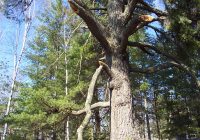Trivia: What name do we call this tree (the oldest on our property) and how old do we think she might be? (answer at bottom)
"It may be mentioned here that compared to lemons, the amount of vitamin C enclosed by the needles of white pine trees are five times more in terms of weight. Thus, an outstanding aromatic herbal tea (tisane) may be prepared with the needles of white pine. In addition, the cambium (a layer of delicate meristematic tissue between the inner bark and the wood) of white pine is also eaten by people and is an important source of resveratrol - an amalgam present naturally in grapes, mulberries, peanuts and other plants or food products that help to protect against cancer and cardiovascular disease owing to its antioxidant, anti-mutagen and anti-inflammatory actions)." (Source: see more at http://www.herbs2000.com/herbs/herbs_pine_white.htm )

Minnesota's logging industry stemmed directly from it's vast extent of white pine (too bad they didn't replant as they went!). Akeley's sawmill was the largest in the world from early 1900's until 1916 when it burned down. Lumberjacks did not fell trees in summer - instead they created snow paths through woods and used iced-over river systems to sled heavy logs from place to place. In spring thaw, the logs already in a waterway would be easier to push downstream to manufacturing plants.

Branches broken in April blizzard 2008

Pic taken around 1968 here at CWC - view of our white pine tree at right (Cabin #14 not built as Playhouse yet directly behind her.)
TRIVIA ANSWER: "Luna" is the name Big John dubbed her back in early 2001. Being approximately six inches less in girth than the largest one in Itasca State Park, which they estimate at around 300 years old, we think her age is about the same.
Please do not scrape "Luna" - you might find sap on trees back on the Walking Trails - help yourself!
- Grows 50 to 100 feet tall, usually where there are limestone outcroppings and porous soils with good internal drainage.
- The leaves are needles 3 to 5 inches long, bluish green on the upper surface, whitish beneath and occurring in bundles of five.
- The needles remain on the tree for two years.
- The average maturity reached for a white pine is 150 - 200 years; some have been reported to be 450 years old.
- White pine's features - tall, large, and straight - made it ideal for ship masts.
- Although relatively pure white pine forests exist in Minnesota, this species is more commonly associated with other forest types. In fact, inventory statistics show that of the white pine present in Minnesota, more than 72 percent exist in other forest types such as aspen, jack pine, and red pine. Wwhite pine occurs in 23 forest types. Statistics show that white pine is present on nearly 1,000,000 acres in Minnesota. This represents an increase of nearly 17,000 acres over the 1977 acreage with a white pine component.
- White pine is being managed on a sustainable basis. Inventory figures from 1990 show that white pine growth exceeds removals by 46 percent. Further, the amount of standing white pine inventory increased by 27 percent from 1977-1990. Since 1990, the Department of Natural Resources and the Superior National Forest have reduced the amount of white pine sold for harvest by 504 to 855 percent, respectively.
- Over one million white pine seedlings are being planted in Minnesota each year. On average more than 30 white pine trees are being planted for every tree harvested. In addition, the DNR has formed a technical team to develop a plan that will enhance white pine growth.







